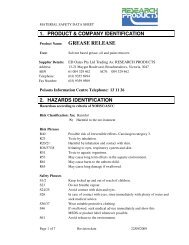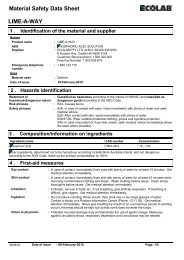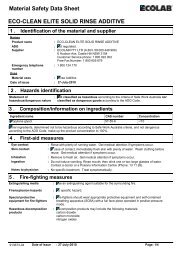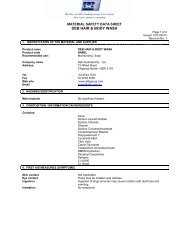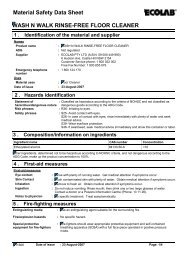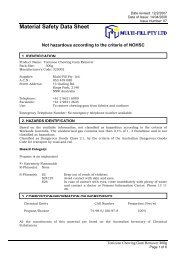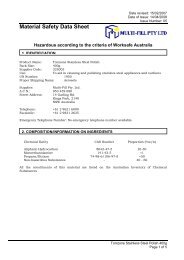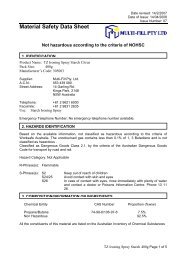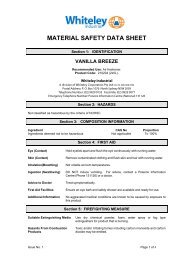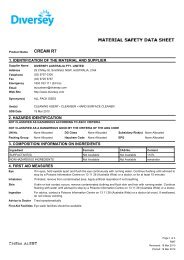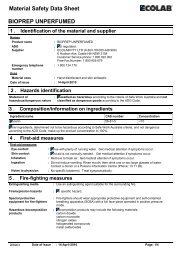Diversey - Pinnacle - msds - Rapidcleanperth.com.au
Diversey - Pinnacle - msds - Rapidcleanperth.com.au
Diversey - Pinnacle - msds - Rapidcleanperth.com.au
Create successful ePaper yourself
Turn your PDF publications into a flip-book with our unique Google optimized e-Paper software.
Product NamePINNACLE1. IDENTIFICATION OF THE MATERIAL AND SUPPLIERSupplier NameAddressTelephoneFaxEmergencyEmailWeb SiteSynonym(s)DIVERSEY AUSTRALIA PTY. LIMITED29 Chifley St, Smithfield, NSW, AUSTRALIA, 2164(02) 9757 0300(02) 9725 57671800 033 111 (24 hrs)<strong>au</strong>custserv@diversey.<strong>com</strong>http://www.diversey.<strong>com</strong>ALL PACK SIZESUse(s)SDS DateFLOOR POLISH13 Aug 20102. HAZARDS IDENTIFICATIONNOT CLASSIFIED AS HAZARDOUS ACCORDING TO SAFE WORK AUSTRALIA CRITERIANOT CLASSIFIED AS A DANGEROUS GOOD BY THE CRITERIA OF THE ADG CODEUN No.None Allocated DG Class None Allocated Subsidiary Risk(s) None AllocatedPacking GroupNone AllocatedHazchem CodeNone Allocated3. COMPOSITION/ INFORMATION ON INGREDIENTSIngredient Formula CAS No. ContentNON HAZARDOUS INGREDIENTS Not Available Not Available 100%4. FIRST AID MEASURESEyeInhalationSkinIngestionAdvice to DoctorIf in eyes, hold eyelids apart and flush continuously with running water. Continue flushing until advised to stop by aPoisons Information Centre, a doctor, or for at least 15 minutes.If inhaled, remove from contaminated area. Apply artificial respiration if not breathing.If skin or hair contact occurs, remove contaminated clothing and flush skin and hair with running water. Continueflushing with water until advised to stop by a Poisons Information Centre or a doctor.For advice, contact a Poison Information Centre on 13 11 26 (Australia Wide) or a doctor (at once).Treat symptomatically.First Aid Facilities Eye wash facilities should be available.5. FIRE FIGHTING MEASURESFlammabilityFire andExplosionExtinguishingNon flammable. May evolve toxic gases (carbon oxides, hydrocarbons) when heated to de<strong>com</strong>position.Treat as per requirements for Surrounding Fires: Evacuate area and contact emergency services. Remain upwindand notify those downwind of hazard. Wear full protective equipment including Self Contained BreathingApparatus (SCBA) when <strong>com</strong>bating fire. Use waterfog to cool intact containers and nearby storage areas.Prevent contamination of drains or waterways.Page 1 of 4RMTReviewed: 13 Aug 2010Printed: 13 Aug 2010
Product NameHazchem CodePINNACLENone Allocated6. ACCIDENTAL RELEASE MEASURESSpillageContact emergency services where appropriate. Use personal protective equipment. Clear area of all unprotectedpersonnel. Ventilate area where possible. Contain spillage, then cover / absorb spill with non-<strong>com</strong>bustibleabsorbant material (vermiculite, sand, or similar), collect and place in suitable containers for disposal. Eliminate allignition sources.7. STORAGE AND HANDLINGStorageHandlingStore in a cool, dry, well ventilated area, removed from oxidising agents, acids and foodstuffs. Ensure containersare adequately labelled, protected from physical damage and sealed when not in use.Before use carefully read the product label. Use of safe work practices are re<strong>com</strong>mended to avoid eye or skincontact and inhalation. Observe good personal hygiene, including washing hands before eating. Prohibit eating,drinking and smoking in contaminated areas.8. EXPOSURE CONTROLS/ PERSONAL PROTECTIONExposure StdsNo exposure standard(s) allocated.Biological LimitsEngineeringControlsPPENo biological limit allocated.Avoid inhalation. Use in well ventilated areas. Where an inhalation risk exists, mechanical extraction ventilation isre<strong>com</strong>mended.Personal Protective Equipment is not required under normal conditions of use. Protection of hands: Rinseand dry hands after use. For prolonged contact protection for the skin may be necessary.Eye protection: Safety glasses are not normally required. However, their use is re<strong>com</strong>mended in those caseswhere handling the undiluted product involves a risk of splashing. With prolonged use, wear: rubber or PVCgloves and safety glasses.9. PHYSICAL AND CHEMICAL PROPERTIESAppearance OPAQUE WHITE LIQUID Solubility (water) SOLUBLEOdour CHARACTERISTIC ODOUR Specific Gravity 1.03 (Approximately)pH 8.5 to 10.0 % Volatiles NOT AVAILABLEVapour Pressure NOT AVAILABLE Flammability NON FLAMMABLEVapour Density NOT AVAILABLE Flash Point NOT RELEVANTBoiling Point NOT AVAILABLE Upper Explosion Limit NOT RELEVANTMelting Point NOT AVAILABLE Lower Explosion Limit NOT RELEVANTEvaporation RateNOT AVAILABLE10. STABILITY AND REACTIVITYChemical StabilityConditions to AvoidMaterial to AvoidHazardousDe<strong>com</strong>positionProductsHazardous ReactionsStable under re<strong>com</strong>mended conditions of storage.Avoid heat, sparks, open flames and other ignition sources.In<strong>com</strong>patible with oxidising agents and acids (eg. nitric acid).May evolve toxic gases (carbon oxides, hydrocarbons) when heated to de<strong>com</strong>position.Hazardous polymerization is not expected to occur.Page 2 of 4RMTReviewed: 13 Aug 2010Printed: 13 Aug 2010
Product NamePINNACLE11. TOXICOLOGICAL INFORMATIONHealth HazardSummaryEyeInhalationSkinIngestionToxicity DataEnvironmentUse safe work practices to avoid eye or skin contact and inhalation. Due to the low vapour pressure of thisproduct, an inhalation hazard is not anticipated with normal use.Contact may result in irritation, lacrimation, pain and redness.Over exposure to vapours may result in irritation of the nose and throat, with coughing. High level exposure mayresult in dizziness, n<strong>au</strong>sea and headache. Due to the low vapour pressure, an inhalation hazard is not anticipatedwith normal use.Prolonged or repeated contact may result in mild irritation, rash and dermatitis.Ingestion may result in gastrointestinal irritation, n<strong>au</strong>sea, vomiting, headache and diarrhoea.No LD50 data available for this product.12. ECOLOGICAL INFORMATIONLimited ecotoxicity data was available for this product at the time this report was prepared. Ensure appropriatemeasures are taken to prevent this product from entering the environment.13. DISPOSAL CONSIDERATIONSWaste DisposalLegislationFor small amounts absorb with sand, vermiculite or similar and dispose of to an approved landfill site. Contact themanufacturer for additional information if larger amounts are involved.Dispose of in accordance with relevant local legislation.14. TRANSPORT INFORMATIONNOT CLASSIFIED AS A DANGEROUS GOOD BY THE CRITERIA OF THE ADG CODEShipping NameUN No.Packing GroupNone AllocatedNone Allocated DG Class None Allocated Subsidiary Risk(s) None AllocatedNone Allocated Hazchem Code None Allocated15. REGULATORY INFORMATIONPoison ScheduleAICS16. OTHER INFORMATIONAdditionalInformationA poison schedule number has not been allocated to this product using the criteria in the Standard for the UniformScheduling of Drugs and Poisons (SUSDP).All chemicals listed on the Australian Inventory of Chemical Substances (AICS).ACRYLIC - WATER BASED COMPOUNDS: It should be noted that most water based paints and acrylic orthermoplastic resins may contain small percentage of solvents, usually less than 5%. The solvent is used as adispersion agent for the resin of choice. This solvent <strong>com</strong>ponent may present potential respiratory hazards only inpoorly ventilated areas or when sprayed. Those individuals with existing skin disorders should avoid direct contact.RESPIRATORS: In general the use of respirators should be limited and engineering controls employed to avoidexposure. If respiratory equipment must be worn ensure correct respirator selection and training is undertaken.Remember that some respirators may be extremely un<strong>com</strong>fortable when used for long periods. The use of airpowered or air supplied respirators should be considered where prolonged or repeated use is necessary.ABBREVIATIONS:ADB - Air-Dry Basis.BEI - Biological Exposure Indice(s)CAS# - Chemical Abstract Service number - used to uniquely identify chemical <strong>com</strong>pounds.CNS - Central Nervous System.EC No - European Community Number.IARC - International Agency for Research on Cancer.M - moles per litre, a unit of concentration.mg/m3 - Milligrams per cubic metre.NOS - Not Otherwise Specified.NTP - National Toxicology Program.OSHA - Occupational Safety and Health Administration.pH - relates to hydrogen ion concentration using a scale of 0 (high acidic) to 14 (highly alkaline).ppm - Parts Per Million.RTECS - Registry of Toxic Effects of Chemical Substances.Page 3 of 4RMTReviewed: 13 Aug 2010Printed: 13 Aug 2010
Product NamePINNACLETWA/ES - Time Weighted Average or Exposure Standard.HEALTH EFFECTS FROM EXPOSURE:It should be noted that the effects from exposure to this product will depend on several factors including: frequencyand duration of use; quantity used; effectiveness of control measures; protective equipment used and method ofapplication. Given that it is impractical to prepare a Chem Alert report which would en<strong>com</strong>pass all possiblescenarios, it is anticipated that users will assess the risks and apply control methods where appropriate.PERSONAL PROTECTIVE EQUIPMENT GUIDELINES:The re<strong>com</strong>mendation for protective equipment contained within this Chem Alert report is provided as a guide only.Factors such as method of application, working environment, quantity used, product concentration and theavailability of engineering controls should be considered before final selection of personal protective equipment ismade.Report StatusThis document has been <strong>com</strong>piled by RMT on behalf of the manufacturer of the product and serves as themanufacturer's Safety Data Sheet ('SDS').It is based on information concerning the product which has been provided to RMT by the manufacturer orobtained from third party sources and is believed to represent the current state of knowledge as to the appropriatesafety and handling prec<strong>au</strong>tions for the product at the time of issue. Further clarification regarding any aspect ofthe product should be obtained directly from the manufacturer.While RMT has taken all due care to include accurate and up-to-date information in this SDS, it does not provideany warranty as to accuracy or <strong>com</strong>pleteness. As far as lawfully possible, RMT accepts no liability for any loss,injury or damage (including consequential loss) which may be suffered or incurred by any person as aconsequence of their reliance on the information contained in this SDS.Prepared ByRisk Management Technologies5 Ventnor Ave, West PerthWestern Australia 6005Phone: +61 8 9322 1711Fax: +61 8 9322 1794Email: info@rmt.<strong>com</strong>.<strong>au</strong>Web: www.rmt.<strong>com</strong>.<strong>au</strong>SDS Date13 Aug 2010End of ReportPage 4 of 4RMTReviewed: 13 Aug 2010Printed: 13 Aug 2010



